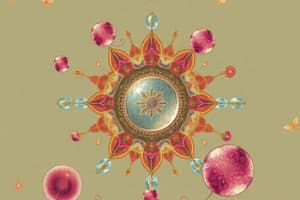Podcast
Questions and Answers
What is Biochemistry?
What is Biochemistry?
Study of processes that take place in organisms.
What is Matter?
What is Matter?
Anything that has weight and takes up space.
What are Elements?
What are Elements?
All matter is composed of fundamental substances.
What are Compounds?
What are Compounds?
What are Bulk Elements?
What are Bulk Elements?
What are Trace Elements?
What are Trace Elements?
What are Ultratrace Elements?
What are Ultratrace Elements?
What are Atoms?
What are Atoms?
What are Electrons?
What are Electrons?
What are Protons?
What are Protons?
What are Neutrons?
What are Neutrons?
What is Atomic Number?
What is Atomic Number?
What is Atomic Weight?
What is Atomic Weight?
What are Isotopes?
What are Isotopes?
What is an Unstable Isotope?
What is an Unstable Isotope?
What is a Molecule?
What is a Molecule?
What are Bonds?
What are Bonds?
What is the Octet Rule?
What is the Octet Rule?
What does Inert mean?
What does Inert mean?
What are Ions?
What are Ions?
What is an Ionic Bond?
What is an Ionic Bond?
What is a Covalent Bond?
What is a Covalent Bond?
What are Polar Molecules?
What are Polar Molecules?
What is a Hydrogen Bond?
What is a Hydrogen Bond?
What are Chemical Reactions?
What are Chemical Reactions?
What are Reactants?
What are Reactants?
What are Products?
What are Products?
What is a Synthesis Reaction?
What is a Synthesis Reaction?
What is a Decomposition Reaction?
What is a Decomposition Reaction?
What is an Exchange Reaction?
What is an Exchange Reaction?
What is a Reversible Reaction?
What is a Reversible Reaction?
What are Catalysts?
What are Catalysts?
What are Electrolytes?
What are Electrolytes?
What are Acids?
What are Acids?
What are Bases?
What are Bases?
What is Salt?
What is Salt?
What does pH represent?
What does pH represent?
What is Alkalosis?
What is Alkalosis?
What is Acidosis?
What is Acidosis?
What are Organic Substances?
What are Organic Substances?
What are Inorganic Substances?
What are Inorganic Substances?
What is Water?
What is Water?
What is Oxygen?
What is Oxygen?
What is Carbon Dioxide?
What is Carbon Dioxide?
What are Inorganic Salts?
What are Inorganic Salts?
What are Bicarbonate ions?
What are Bicarbonate ions?
What are Calcium ions?
What are Calcium ions?
What are Carbonate ions?
What are Carbonate ions?
What are Chloride ions?
What are Chloride ions?
What are Hydrogen ions?
What are Hydrogen ions?
What are Magnesium ions?
What are Magnesium ions?
What are Phosphate ions?
What are Phosphate ions?
What are Potassium ions?
What are Potassium ions?
What are Sodium ions?
What are Sodium ions?
What are Sulfate ions?
What are Sulfate ions?
What are Carbohydrates?
What are Carbohydrates?
What are Lipids?
What are Lipids?
What are Proteins?
What are Proteins?
What are Monosaccharides?
What are Monosaccharides?
What are Disaccharides?
What are Disaccharides?
What are Polysaccharides?
What are Polysaccharides?
What is the significance of reactions involving carbohydrates?
What is the significance of reactions involving carbohydrates?
What are Storage Carbohydrates?
What are Storage Carbohydrates?
What are Structural Carbohydrates?
What are Structural Carbohydrates?
What do Lipids include?
What do Lipids include?
What are the functions of fats?
What are the functions of fats?
What are Phospholipids?
What are Phospholipids?
Flashcards are hidden until you start studying
Study Notes
Biochemistry and Matter
- Biochemistry studies the processes occurring in living organisms.
- Matter is defined as anything that has weight and occupies space.
- Elements are fundamental substances that make up all matter.
- Compounds consist of two or more elements combined.
Elements and Body Composition
- Bulk elements (O₂, H₂, N₂, C, P, S) account for 95% of the human body.
- Trace elements are minerals essential in very small amounts.
- Ultratrace elements are vital in minute amounts but can be toxic in larger quantities.
Atomic Structure and Isotopes
- Atoms are the basic building blocks of matter, comprised of protons, neutrons, and electrons.
- Electrons are negatively charged particles, while protons carry a positive charge, and neutrons are neutral.
- The atomic number indicates the number of protons in an atom’s nucleus, whereas atomic weight is the sum of protons and neutrons.
- Isotopes are atoms with the same number of protons but differing numbers of neutrons.
Bonds and Chemical Properties
- Molecules consist of two or more atoms united together.
- Ionic bonds arise from the transfer of electrons between ions, creating charged atoms.
- Covalent bonds are formed through the sharing of electrons between atoms.
- Polar molecules have a covalent bond where electrons are unequally shared, resulting in slight charges at either end (e.g., water).
- Hydrogen bonds occur when a hydrogen atom is covalently bonded to an electronegative atom, interacting with another electronegative atom.
Chemical Reactions
- Chemical reactions involve breaking and forming chemical bonds, resulting in reactants transforming into products.
- Synthesis reactions combine simple substances into more complex ones (A + B → AB).
- Decomposition reactions separate a substance into simpler substances (AB → A + B).
- Exchange reactions involve the swapping of components between molecules (AB + CD → AD + CB).
- Reversible reactions can form reactants from products and vice versa (A + B ⇌ AB).
- Catalysts speed up chemical reactions without being consumed.
- Electrolytes ionize in water and are essential for various biological functions.
Acids, Bases, and pH
- Acids release hydrogen ions in solution; bases produce ions that can combine with hydrogen ions.
- Salts are products formed from the reaction between acids and bases.
- pH measures the concentration of hydrogen ions; a pH above 7.45 indicates alkalosis, while a pH below 7.35 indicates acidosis.
Organic and Inorganic Compounds
- Organic substances contain carbon and hydrogen, including carbohydrates, lipids, proteins, and nucleic acids, characterized by their ring or chain structures.
- Inorganic substances (e.g., water, oxygen, carbon dioxide) do not contain carbon and hydrogen.
Essential Biological Compounds
- Water is crucial for cellular reactions and transports chemicals and heat.
- Oxygen is essential for releasing energy from glucose.
- Carbon dioxide is a byproduct of metabolic activities.
- Inorganic salts provide necessary ions for metabolic processes.
Importance of Ions
- Bicarbonate ions maintain acid-base balance.
- Calcium ions are essential for bone development, muscle contractions, and blood clotting.
- Phosphate ions are important for ATP production and nucleic acid synthesis.
- Sodium and potassium ions are vital for cell membrane polarization and water balance.
Carbohydrates and Their Functions
- Carbohydrates are sugars or starches that provide energy to cells; building blocks are simple sugars like glucose.
- Types of carbohydrates include monosaccharides (single sugars), disaccharides (double sugars), and polysaccharides (many sugars).
- Storage carbohydrates: starch in plants, glycogen in animals.
- Structural carbohydrates: cellulose in plants, chitin in animals and fungi.
Lipids and Proteins
- Lipids serve as energy reserves and structural components, built from glycerol and fatty acids.
- Fats store more energy than carbohydrates and offer protection and insulation for organs.
- Proteins serve numerous functions, including structural support, energy sources, hormones, receptors, antibodies, and enzymes, with amino acids as their building blocks.
Studying That Suits You
Use AI to generate personalized quizzes and flashcards to suit your learning preferences.




